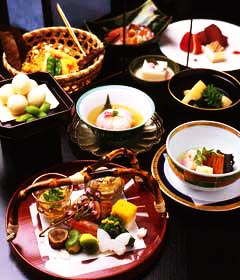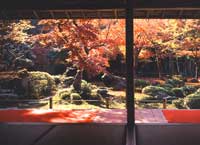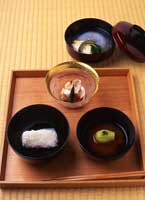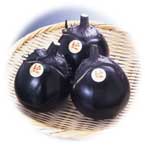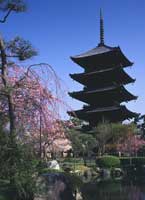|
|
|||||||
|
|
|||||||
|
|||||||
| | Web Japan >> | Trends in Japan >> | J-food >> | Kyoto, Spiritual Home of Japanese Cuisine | |
|
KYOTO, SPIRITUAL HOME OF JAPANESE CUISINE Ancient Capital Offers a Mouthwatering Taste of Tradition (October 3, 2007) For more than 1,000 years, beginning in 794, the ancient city of Kyoto was the capital of Japan. Lying in the middle of the Japanese archipelago in a basin-shaped valley and surrounded by mountains on three sides, Kyoto’s distinctive surroundings change with each season. Kyo-ryori (Kyoto cuisine) is the model for Japanese culinary culture, which places great importance on the use of seasonal ingredients.
A Fusion of Cooking Styles Located close to the Sea of Japan and Lake Biwa, Japan’s largest lake, Kyoto enjoyed a well-developed water transportation system that enabled delivery of the highest quality foodstuffs from around the country. The city was also a magnet for chefs who wanted to hone their culinary skills. Inspired by the Tea Ceremony
The basis of kaiseki-ryori is ichiju-sansai (“one soup, three sides”), consisting of a bowl of miso soup and three okazu (side dishes) along with a bowl of rice. Different cooking techniques are applied to each of the three okazu. One of the side dishes, called mukozuke, may feature sashimi. Another, called nimono, is made by simmering fish or vegetables in a unique Japanese stock made with dried bonito fish flakes and konbu (dried kelp). Nimono is carefully arranged and served in a bowl with a generous portion of soup stock. The third side dish, called yakimono, usually consists of fish, such as ayu (sweetfish), that has been salted and grilled. To cleanse the palate after eating ichiju-sansai, a plain, lightly salted broth called hashiarai is served. Topping off the meal is a dish called hassun, which contains a mixture of ingredients from the sea and mountains, such as seaweed and yam. Delicately prepared with carefully selected ingredients using sophisticated techniques, all of these dishes are served one at a time in small amounts. Careful attention is paid to how food is arranged and presented, following the wabi-sabi concept of beauty emphasized in the tea ceremony, which focuses on simplicity and understated elegance. There are many restaurants in Kyoto with menus based on kaiseki-ryori that offer a greater number of side dishes served in larger portions with more colorful garnishes using seasonal flowers and leaves. Sampling the cuisine of the city is a chance to experience the “spirit of hospitality” and the “spirit of tea.” Unique Ingredients No visitor to Kyoto should go home without sampling dishes made with yuba, which was developed along with shojin-ryori. Yuba is made from soybeans that have been stone ground and boiled in a cauldron. The soy milk is then boiled in an open shallow pan, forming a film or skin on the liquid surface. This is yuba, which is collected and dried into yellowish sheets. There are a number of ways to eat yuba, such as wrapping it around vegetables before simmering them or deep frying it to make it crispy. Yuba has become quite popular with Western chefs since it is high in protein and low in fat. Easy to carry and pack, yuba is an excellent choice for a souvenir. Copyright (c) 2007 Web Japan. Edited by Japan Echo Inc. based on domestic Japanese news sources. Articles presented here are offered for reference purposes and do not necessarily represent the policy or views of the Japanese Government. |
SAPPORO, HOKKAIDO�S CULINARY HUB (August 30, 2007) HOKKAIDO, CORNUCOPIA OF FINE FOODS (August 7, 2007) |
|||||||||||||||||||||||||
|
||||||||||||||||||||||||||
